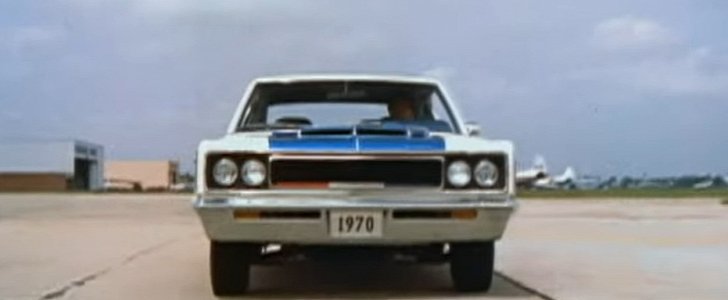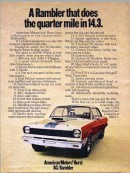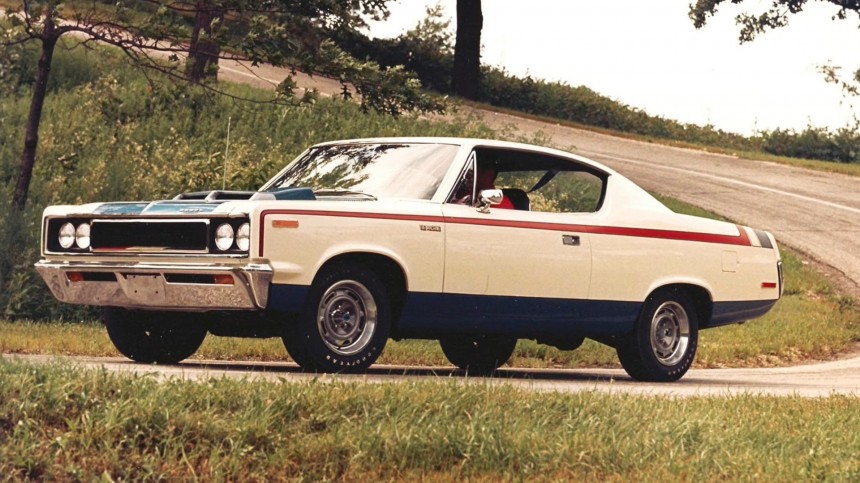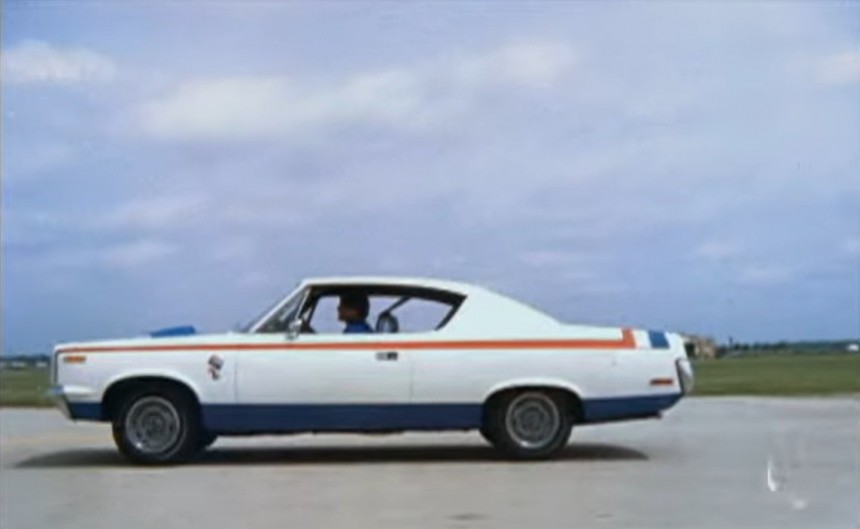Ask anyone what is more important in a bar-fight: who throws the first punch, or who is the last one standing? The answer will be "the last one standing". But there was the small AMC brand that did both.
The debate about which vehicle was the first muscle car may never end. Some will say that the Hudson Hornet, the other will say that the AMC Rambler Rebel with its electronic fuel injection was ahead of the game. Either way, the Hudson Motor Car Company merged with Nash-Kelvinator Corporation and formed AMC in 1954.
But there is a glitch: while the Hudson Hornet was a two-door coupe with a V8 under the hood and rear-wheel-drive, the Rambler had four doors and better performance than most cars on the market. In fact, in 1957, a fuel-injected Rambler could do a 0-60 mph (0-97 kph) run in 7.5 seconds, and in an independent race it won over a Chevrolet Corvette C1 with mechanical fuel injection.
But it was a four-door sedan, and some would not consider it a true muscle car. For those times, it was like the Aston Martin Rapide or the Porsche Panamera. So, leave us a comment below about who do you think was the first muscle car out of these two: the Hudson Hornet or the AMC Rambler?
Over the following decade, the AMC Rambler Rebel lost its "Rambler" name and remained only as "Rebel" in the AMC lineup, and it was available as a sedan, station wagon, coupe, and convertible. Moreover, it was a true international muscle car since it was also assembled in Europe and sold as the Rambler-Renault Rebel in Mexico, Costa Rica, New Zealand, and Australia. The European taxation rules ruled out the big engines, though, and only the inline-six units were available.
For 1969, AMC marketed an SC/Rambler as a drag strip car. It was just a preview about what AMC could do. In 1970, the sportiest AMC Rebel appeared. It was called "The Machine" by its parents and it was, truly, one of the best muscle cars of the era.
The high-powered Rebel was marketed with a 390ci (6.4-liter) V8 engine that offered 340 hp as standard. It featured a functional scoop on the hood, with a valve that opened and closed to help the engine heat up or offer more cold air for the intake. In the same scoop, but in front of the driver, AMC installed a tachometer so that the driver shouldn't take the eyes from the road. It was lighted and marked up to 8000 rpm. The speedometer was marked up to 120 mph (196 kph).
The two-door vehicle was fitted as standard with a four-speed Borg-Warner manual gearbox and a positronic differential. Most of the other muscle cars from that era had a standard automatic transmission and the manual was available at extra cost. For those who were looking for an automatic, AMC offered a 3-speed version with a 3.19:1 rear differential to keep the fuel consumption and the emissions at the newly formed mandatory standards from the EPA.
The heavy-duty shocks and springs in the rear were a carryover from the station wagon version. In the beginning, it was available only in a red white and blue color scheme, with factory side strips and the badges "The Machine" on the fenders and dashboard.
While the standard features were good especially for its low price, the dealers could also add some other options. In the late '60s, new rules and regulations has been imposed on car manufacturers. By installing various equipment at the dealer's shops, AMC managed to avoid those regulations.
There was a so-called "service pack", which was actually a performance package that could raise the output by 66 hp from the standard 340 hp. The standard rear axle ratio was either 3.54:1 or 3.91:1 from the factory. A ridiculously high 5.0:1 ratio was available as a dealer option. The standard vehicle wasn't as fast as a 427 Corvette, though. Some recorded figures for the car were a 0-60 mph time of in 6.8 seconds and a 14.4 seconds time for a quarter-mile run. With the "Service pack," it was way faster.
The Machine was the last true muscle car. The decline started in 1971 with bigger insurance costs and EPA rules and regulations. By 1973, the additional costs for purchasing a muscle car were so high that only a handful of vehicles were sold. Moreover, the 1973 oil crisis killed all the last remaining models from the golden age of the muscle car era.
While some vehicles from that era still populated the roads like shades of their former glory, the AMC Rebel "The Machine" started as a true performer and its production was stopped when it was still high on the podium rather than crawling on the streets with a formerly glorious name on it. Its follower, named Matador, was a more appealing car for the masses, but with less performance.
In factory trim, The Machine was a serious contender for most of the cars on the market and, with the dealer's packages, was a fierce competitor on the drag strips. Maybe it wasn't the fastest of them all, but it was the only one that came late to the bar, put up a more than decent fight, and then stormed out the saloon doors while its former contenders remained fallen on the floor.
But there is a glitch: while the Hudson Hornet was a two-door coupe with a V8 under the hood and rear-wheel-drive, the Rambler had four doors and better performance than most cars on the market. In fact, in 1957, a fuel-injected Rambler could do a 0-60 mph (0-97 kph) run in 7.5 seconds, and in an independent race it won over a Chevrolet Corvette C1 with mechanical fuel injection.
But it was a four-door sedan, and some would not consider it a true muscle car. For those times, it was like the Aston Martin Rapide or the Porsche Panamera. So, leave us a comment below about who do you think was the first muscle car out of these two: the Hudson Hornet or the AMC Rambler?
For 1969, AMC marketed an SC/Rambler as a drag strip car. It was just a preview about what AMC could do. In 1970, the sportiest AMC Rebel appeared. It was called "The Machine" by its parents and it was, truly, one of the best muscle cars of the era.
The high-powered Rebel was marketed with a 390ci (6.4-liter) V8 engine that offered 340 hp as standard. It featured a functional scoop on the hood, with a valve that opened and closed to help the engine heat up or offer more cold air for the intake. In the same scoop, but in front of the driver, AMC installed a tachometer so that the driver shouldn't take the eyes from the road. It was lighted and marked up to 8000 rpm. The speedometer was marked up to 120 mph (196 kph).
The two-door vehicle was fitted as standard with a four-speed Borg-Warner manual gearbox and a positronic differential. Most of the other muscle cars from that era had a standard automatic transmission and the manual was available at extra cost. For those who were looking for an automatic, AMC offered a 3-speed version with a 3.19:1 rear differential to keep the fuel consumption and the emissions at the newly formed mandatory standards from the EPA.
The heavy-duty shocks and springs in the rear were a carryover from the station wagon version. In the beginning, it was available only in a red white and blue color scheme, with factory side strips and the badges "The Machine" on the fenders and dashboard.
While the standard features were good especially for its low price, the dealers could also add some other options. In the late '60s, new rules and regulations has been imposed on car manufacturers. By installing various equipment at the dealer's shops, AMC managed to avoid those regulations.
The Machine was the last true muscle car. The decline started in 1971 with bigger insurance costs and EPA rules and regulations. By 1973, the additional costs for purchasing a muscle car were so high that only a handful of vehicles were sold. Moreover, the 1973 oil crisis killed all the last remaining models from the golden age of the muscle car era.
While some vehicles from that era still populated the roads like shades of their former glory, the AMC Rebel "The Machine" started as a true performer and its production was stopped when it was still high on the podium rather than crawling on the streets with a formerly glorious name on it. Its follower, named Matador, was a more appealing car for the masses, but with less performance.
In factory trim, The Machine was a serious contender for most of the cars on the market and, with the dealer's packages, was a fierce competitor on the drag strips. Maybe it wasn't the fastest of them all, but it was the only one that came late to the bar, put up a more than decent fight, and then stormed out the saloon doors while its former contenders remained fallen on the floor.

















